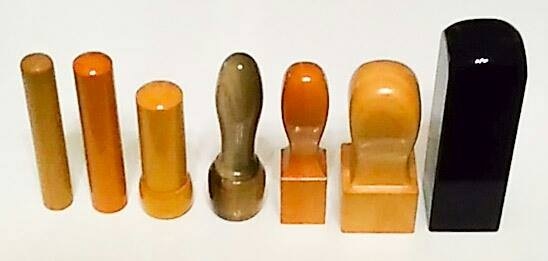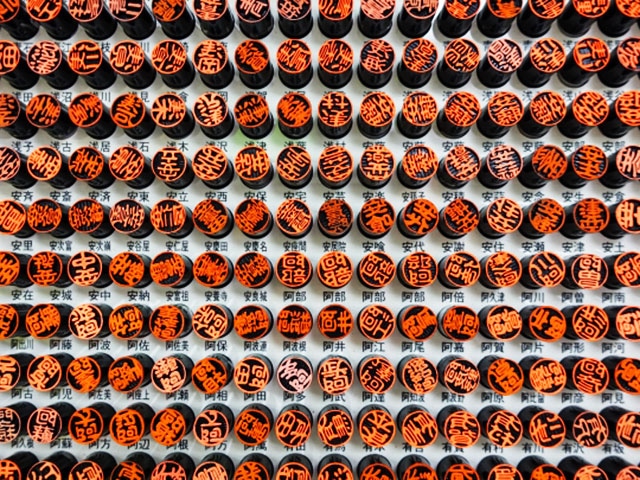2025/06/30 17:33
English Summary below◆
1. 印章 ― 名前を刻む文化
日本には、サインの代わりにハンコを使う文化があります。
婚姻届や契約書、時には学校の連絡帳に至るまで。
「意思表示」の道具として社会のあらゆる場面に登場するハンコは、「自分自身の存在」や「未来への決意」を代理で表現する、まるで相棒のような存在です。
名前を刻んだ「ハンコ」と呼ばれるその物体は、正しくは「印章(いんしょう)」と呼ばれます。
そして印章と朱肉で紙に捺したものを「印影(いんえい)」と呼び、登録された印章の印影を「印鑑(いんかん)」と言います。
印章:ハンコそのもの。物体としての呼称。
印影:印章を紙などに捺したもの。
印鑑:登録された印章の印影。印の真偽を見極めるための基礎。
印材:彫刻前のハンコの素材。※冒頭の写真
一人ひとりが印章を持ち、その小さな円の中に「決意」や「責任」を込める。
そうした日本人の価値観や社会構造を映し出す印章文化が、長く育まれてきました。

▲様々な印材
2. 印章の歴史
印章のルーツは、メソポタミア文明にあります。
石や貝などに模様や文字を彫り、粘土などに捺しつけて使用していました。
これには所有権の表示だけでなく、魔除けやお守りとしての意味もあり、様々な階級の人に広く使われていました。
同様に、エジプト文明やインダス文明でも印章は発掘されており、文明ごとに形状などに特徴があります。
中国では、夏・殷・周の時代にはすでに印章文化が存在していました。
これら古代文明のときはまだ、紙が発明されていなかったので粘土に捺す用途が多く、印章は「白文(文字の部分が白く出る)」の形式で作られていました。
日本の印章史を語る上で有名なのは「金印」ですが、これは当時の中国からの贈答品で、日本国内での印章文化の始まりを示す証拠とは言いづらい存在です。
現存する日本最古の印章は、古墳時代の「大連(おおむらじ)の印」とされています。
701年(飛鳥時代)の「大宝律令」で、天皇の印「御璽(ぎょじ)」や、行政機関が用いる官印・公印が制度化され、寺社や地方役所でも印章が使われるようになり、のちに私印も登場します。
これらの時代の印章は、既に紙が発明されているので「朱文(文字の部分が赤く出る)」の形式で彫られています。
その後、秀吉の命により印判師(印章職人)が誕生し、江戸時代には一般庶民にも広がりました。
そして明治時代に入ると、太政官布告により印章制度が整備されました。
ゴム印の登場も、明治時代になります。

▲メソポタミアの円筒印章
3. 印章の分類 ― 用途・技法・素材
一口に「ハンコ」と言っても、その種類は多岐にわたります。
用途や彫り方、素材の違いによって、それぞれに相応しい形があります。
3-1. 用途別の分類
印章は使用される場面によって、求められる役割や形式が異なります。
以下は、日常的に使われる主な分類です。
実用印
◎実印(じついん)
公的な契約に使う、もっとも重要な印。
自治体に登録する必要があり、不動産売買や遺産相続など、人生の節目で使われます。
法的拘束力が強く、印影には法令による規定があります。
◎銀行印(ぎんこういん)
金融機関での手続きに使用されます。
◎認印(みとめいん)
日常的な書類への押印に使われます。
その他にも代表者印、社印、割印、訂正印があります。
素材は主に、木材、動物性素材、金属、樹脂の印材が使用され、朱文で彫られます。
石印
書画などの芸術作品に使用する落款印が代表的です。名前や雅号のほか、縁起の良い漢字や故事成語を彫ることもあります。
朱白はその用途次第です。
その他
住所印や封緘印、蔵書印のような事務用品のほか、遊び心や装飾性を重視したスタンプなども人気です。
3-2. 技法別の分類
製作工程による分類です。
用途や予算、好みに応じて選ぶのが良いでしょう。
手彫り
字入れから仕上げまで、職人が一文字ずつ筆で書き、印刀で彫る印章。
その職人の「癖」や「揺らぎ」が、唯一無二の表情を作ります。
防犯性が高く、実印として最も信頼されます。
手仕上げ
コンピュータ書体に頼らず、また仕上げの工程を手仕事で行います。
途中の荒彫りの工程で、機械を使います。
中間的な選択肢として、コストと個性のバランスを取る人に選ばれます。
機械彫り
パソコン上で作成された文字を機械で彫刻します。
大量生産に向いており、安価で手に入りますが、同じデザインが複数存在するリスクがあります。
3-3. 素材別の分類
印章の材質は、使用目的や好みによって選ばれます。
印材は、素材の色や希少性で選ばれることが多いです。
木材(柘、茜など)
古くから親しまれてきた素材。
経年変化が味になる点も魅力。
動物性印材(牛角・象牙など)
高級印材として知られ、実用印使われます。
現在、象牙は登録業者以外の取扱いは禁止されています。
樹脂(ラクト材など)
安価な機械彫りで使われることが多いです。
金属(チタンなど)
ひじょうに堅いため、金属の種類によっては、手彫りでの製造はできません。
石材(青田石・巴林石など)
芸術性に富んだ落款印などで使用されます。
自然素材のもつ偶然性が、作品の表現に大きく影響をあたえます。
ゴム
実用印では使用せず、事務用品や趣味のスタンプで使います。
鋳造やレーザーのような機械による製造だけでなく、職人による「彫りゴム」の技法も明治時代に確立されています。
浸透印
あらかじめインキが内蔵されており、朱肉が不要な印章です。
実印、銀行印としての使用はできませんが、認印のような用途では使用できる場面もあります。
既製品や、メーカーにオーダーして購入します。
印章にはそれぞれ役割があり、刻まれる文字や素材、用いられた手法によって、その重みは異なります。

▲石で作成した落款印
4. 印章の制作工程 ― 実用印(手彫り)の場合
日本の伝統的な手彫り印章は、単なる道具ではなく、職人の技術と精神がこもった「工芸品」です。
ここでは、実用印(実印・銀行印・認印)として用いられる手彫り印の一般的な制作工程をご紹介します。
1. 素材選びと用途の確認
まずは、印材を用途や希望に応じて選びます。
実印の場合、直径13.5~18㎜が人気です。
2.印稿の作成
線の太さ、文字の配置、余白の取り方など、職人の個性が一番影響する工程です。
姓名片方にするか、フルネームにするか、どんな配置にするか、どの書体にするかを決めます。
登録する自治体によってルールが違うので、注意が必要です。
文字に誤りがないか、辞書で一字一字確認します。
ポイント
異なる時代の書体を一つの印面に混在させることはしません。
また文字を横に並べる際は、右から配字します。
本来、漢字が生まれた中国も、日本語も、文字は右から書くものだったからです。
3. 字入れ(下書き)
印面(底面)を滑らかに整え、朱墨を塗ります。
作成した印稿をもとに、鏡文字の状態で、墨と筆で印面に直接書き入れます。
4. 荒彫り(あらぼり)
字入れをもとに、印刀で彫ります。
5. 仕上げ
荒彫りの線に沿って、印刀(いんとう)を使って慎重に削ります。
エッジの処理などを行い、滑らかで捺しやすい印章に仕上げます。
6. 完成
朱肉をつけて、捺印します。
問題がなければ、完成です。
ポイント
捺印にも、技術や工夫が必要です。
朱肉のつけ方、紙の準備、捺す際の下敷きなど、各自の工夫が見らえます。
このように、たった数センチの印章には、いくつもの工程と、熟練の技が積み重なっています。

▲手彫り印章のための印刀
5. 印章の文化的意味
日本において印章は、「責任」や「意志」を可視化するための印(しるし)であり、時には儀式的な意味さえ帯びています。
婚姻届、遺産相続、住宅の購入など、人生の節目では必ずといっていいほど、印章が登場します。
そこには「自分の決断に責任を持つ」という精神的な重みが込められます。
そして職人は、その決断が幸せへと繋がることを祈り、小さな円に文字を刻みます。
このように印章は、物に想いを託す価値観を表象する、文化的なアイテムと言えるでしょう。
手彫り印章の世界では、機械では真似できない唯一無二の造形や、作り手の個性が宿ります。
大量生産された既製品では得られない、誰かのためだけに作られた印章は、贈り物や節目の記念品として選ばれることも多いです。
1. Hanko: Japan’s Culture of Names and Identity
In Japan, people often use personal seals—hanko—instead of signatures.
These small seals appear in all kinds of situations, from marriage registration and legal contracts to casual notes from school.
Each one carries a name, and symbolically, a sense of personal responsibility and intention for the future.
Owning your own hanko is like having a part of your identity in your pocket.
Each time it’s used, it represents your voice, your decisions, and your presence—sometimes more powerfully than a signature.

▲Mass-produced Hanko
2. The Origins of Seals
The story of seal begins far earlier—in ancient Mesopotamia.
People there carved designs into stone or shells to stamp onto clay.
These seals served as signs of ownership, magical protection, or personal identity.
Similar seals have been found in ancient Egypt and the Indus Valley, each culture developing distinct styles.
In China, seal culture dates back to the Xia, Shang, and Zhou dynasties.
The oldest surviving seals are from the Shang era.
At that time, paper didn’t exist, so seals were used on clay, and the characters were carved in intaglio (so the charactors appeared white when stamped).
In Japan, the most famous ancient seal is the "Gold Seal", gifted from China around 57 AD.
However, since it was a diplomatic item, it doesn’t mark the beginning of Japan’s own seal usage.
The oldest surviving Japanese-made seal is from the Kofun period and belonged to a court official.
By the year 701, Japan had formalized seal usage in the Taihō Code, influenced by China’s Sui and Tang dynasties.
This system included imperial seals or government seals, eventually expanding to temples and local offices.
Professional seal engravers first appeared under Hideyoshi's rule, then by the Edo period, even commoners were allowed to own and use seals.
Later, in the Meiji era, the seal system was fully standardized by law.
Today, Japan is the only country in the world where personal seals are still legally recognized as official signatures.
This sets hanko(personal seal) apart as not only a cultural artifact, but also a living part of daily life.

▲Gold Seal
3. Types of Hanko
There are many types of hanko in Japan, each suited to a different purpose. They can be classified by use, technique, and material.
3-1. Hanko by Use
• Practical Hanko: Used in everyday life, business, and legal documents.
• Artistic Seals: These are not only used to sign drawings or calligraphy, but also valued as works of art themselves.
• Other Stamps: These include address stamps, library stamps, decorative seals, and fun hobby stamps.
3-2. Hanko by Technique
• Hand-Carved: Each character is written with a brush and carved entirely by hand.
• Semi-Handmade: Rough carving is done by machine, but finishing is done by hand.
• Machine-Made: Fully designed and carved by machine. Affordable and widely available, but easier to copy.
3-3. Hanko by Material
• Wood: Traditional and lightweight, often used for daily-use hanko.
• Animal Horn / Tooth: Premium materials. Ivory is strictly regulated in modern times.
• Plastic / Resin: Affordable and commonly used for machine-made hanko.
• Metal: Durable and sleek. Too hard to be carved by hand.
• Stone: Preferred for artistic seals.
• Rubber: Used in casual or office stamps. Can be machine-cut or hand-carved.
• Pre-Inked Hanko: These contain ink inside and require no ink pad. Convenient, but not valid for official documents.

▲Making an artistic seal "rakkan-in"
4. How a Traditional Hanko is Made (Hand-Carved Practical Hanko)
4. How a Traditional Hanko Is Made (Hand-Carved Practical Hanko)
Traditional hanko are still handcrafted in Japan by skilled artisans.
Here is how one is made, step by step:
1) Material Selection & Purpose Confirmation
The customer chooses a material and specifies the intended use (e.g., for legal documents, bank use, or personal use).
2) Designing
The artisan plans the character layout—deciding the name format, the script style, and how everything fits within the round or square shape.
The design follows traditional cultural rules.
3) Writing the Characters
The face of the hanko is polished smooth and brushed with red ink.
The artisan then handwrites the mirrored characters directly onto the surface using a fine brush.
4) Rough Carving
Using a special blade, the artisan begins to carve the design into the material, following the hand-drawn lines.
5) Final Carving
Fine lines are sharpened, edges are smoothed, and the overall composition is refined to ensure a clear and well-balanced impression.
6) Completion
The finished hanko is tested with red ink on paper.
If needed, small adjustments are made for clarity, balance, and beauty.
Even though the seal face is only a few centimeters wide, each one holds the artisan’s skill, judgment, and care.

▲There is also a national examination for seal engraving, and if you pass you will be awarded a badge of Certified Skilled Worker.
5. The Cultural Meaning of Hanko in Japan Today
In Japan, a hanko is more than just a signature.
From marriage certificates to property contracts, it marks nearly all of life’s major milestones.
It symbolizes intent, responsibility, and sometimes even a sense of ceremony.
And skilled artisans carve your name by hand, hoping that your hanko will guide you toward happiness.
In this way, hanko reflect Japanese values and aesthetics—a culture that entrusts feelings to physical objects.
Even in today’s digital world, handmade hanko are still valued as unique, personal artifacts.
Their one-of-a-kind design and human touch make them popular gifts and keepsakes for life events.
Interestingly, Japan is now the only country in the world where hanko still hold legal authority in official matters.
Countries like Korea and Taiwan once had similar systems, but Japan alone has preserved this tradition under modern law.


